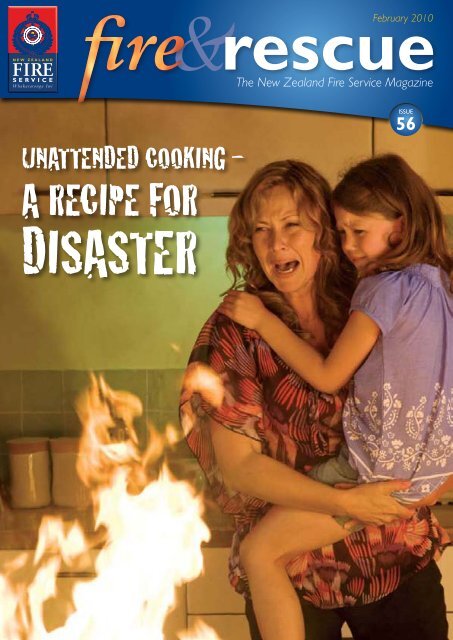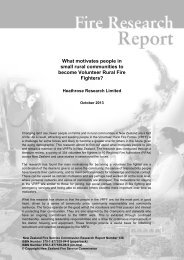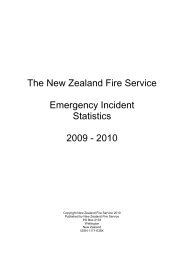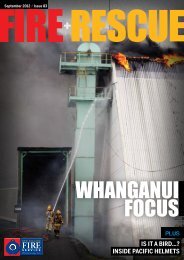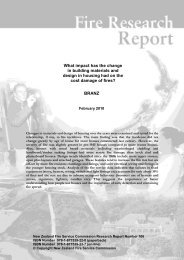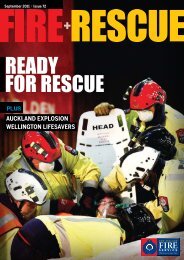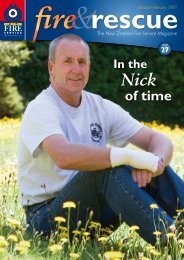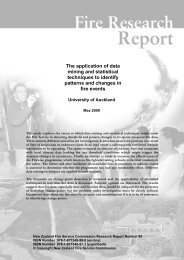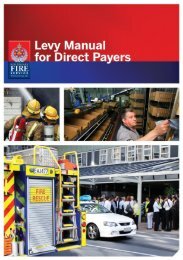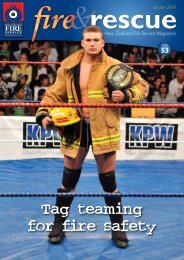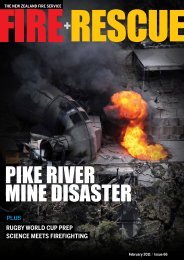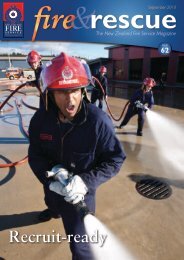Issue 56 - New Zealand Fire Service
Issue 56 - New Zealand Fire Service
Issue 56 - New Zealand Fire Service
Create successful ePaper yourself
Turn your PDF publications into a flip-book with our unique Google optimized e-Paper software.
Unattended cooking –<br />
a recipe for<br />
disaster<br />
February 2010<br />
The <strong>New</strong> <strong>Zealand</strong> <strong>Fire</strong> <strong>Service</strong> Magazine<br />
ISSUE<br />
<strong>56</strong>
February 2010<br />
<strong>Issue</strong> No. <strong>56</strong><br />
<strong>Fire</strong> & Rescue is the flagship<br />
publication of the <strong>New</strong> <strong>Zealand</strong><br />
<strong>Fire</strong> <strong>Service</strong>.<br />
It is produced by Media,<br />
Promotions and Communications,<br />
National Headquarters,<br />
Level 9, 80 The Terrace, Wellington.<br />
Front cover: Terror in the kitchen,<br />
a photo from the new television<br />
campaign.<br />
Back cover: The Get Out! Stay Out! Song<br />
from the Get <strong>Fire</strong>wise programme.<br />
Contributions to <strong>Fire</strong> & Rescue<br />
We welcome ideas for articles, news<br />
and events that would be of interest to<br />
other <strong>Fire</strong> <strong>Service</strong> staff and volunteers.<br />
Draft articles and photos (pictures<br />
need to be at least 1MB) can be<br />
emailed to fire.rescue@fire.org.nz or<br />
contact the editor Karlum Lattimore<br />
on 04 496 3702.<br />
Post written material and photos,<br />
or photo CDs to:<br />
<strong>Fire</strong> & Rescue magazine,<br />
PO Box 2133, Wellington.<br />
(These will be returned on request.)<br />
<strong>Fire</strong> & Rescue is online at:<br />
www.fire.org.nz<br />
ISSN: 1176-6670<br />
All material in <strong>Fire</strong> & Rescue magazine is<br />
copyrighted and may not be reproduced<br />
without the permission of the editor.<br />
4<br />
Cutting Edge<br />
Technology<br />
Cover Story<br />
Partnerships<br />
Need to Know<br />
Equipment Update<br />
<strong>Fire</strong>wise Update<br />
Training <strong>New</strong>s<br />
Incidents<br />
Staying Safe<br />
<strong>New</strong>s<br />
People<br />
Last Words<br />
10<br />
6 9<br />
Rolling out the hazmats ................................................................3<br />
Stand by your pan ............................................................................4<br />
Working with the council –<br />
Waitemata’s success story ..........................................................5<br />
Joining forces to promote fire safety ......................................6<br />
Canterbury initiative ........................................................................7<br />
Looking for information? ................................................................8<br />
The next generation of BA ..........................................................9<br />
<strong>New</strong> standard for PPE ...................................................................9<br />
Noticed the difference in PSL standpipes? .........................9<br />
Get with the programme ..........................................................10<br />
<strong>New</strong> volunteer training material on its way ...................12<br />
Saved by the sprinkler .................................................................14<br />
Think safety .......................................................................................15<br />
Stage 2 National Training Centre..........................................16<br />
<strong>New</strong> online ordering .....................................................................17<br />
A couple of minutes with... Gary Quigan ...........................18<br />
The ‘no limits’ attitude .................................................................19<br />
16<br />
19
Cutting Edge Technology<br />
Rolling out the hazmats<br />
The 17 new dual-role hazmat/command vehicles, their decontamination systems,<br />
supporting equipment and training are now being rolled out to the regions at a rate<br />
of about one a month.<br />
National Manager Special Operations<br />
Jim Stuart-Black, says the rollout is<br />
the culmination of five years of<br />
planning and design and all regions<br />
should have their hazmat capability<br />
fully operational by the Rugby World<br />
Cup in 2011.<br />
“These vehicles and everything they<br />
contain, including the new disposable<br />
splash suits and the detection, identification<br />
and monitoring equipment,<br />
reflect the latest in international<br />
best practice. Much of the design<br />
has been done by the <strong>New</strong> <strong>Zealand</strong><br />
<strong>Fire</strong> <strong>Service</strong> and they will handle any<br />
biological, chemical and radiological<br />
hazards likely to be faced by our<br />
personnel, the public or other<br />
emergency service.”<br />
Jim says the <strong>New</strong> <strong>Zealand</strong> <strong>Fire</strong> <strong>Service</strong><br />
hazmat capability is now among<br />
the best in the world and provides<br />
<strong>New</strong> <strong>Zealand</strong> with a national,<br />
strategic asset.<br />
The project was initiated by the<br />
National Commander Mike Hall,<br />
who saw the need for <strong>New</strong> <strong>Zealand</strong><br />
<strong>Fire</strong> <strong>Service</strong> to be able to<br />
respond rapidly and effectively to a<br />
wide range of situations requiring<br />
contemporary command and control<br />
capabilities and hazardous material<br />
response options.<br />
Each hazmat/command vehicle will<br />
be strategically positioned so that it<br />
can respond in major cities (typically<br />
those with associated ports or<br />
airports) within 20 minutes and<br />
within 60 minutes to the rest of the<br />
country, 90 per cent of the time.<br />
National Advisor Operations John<br />
Sutherland says the decontamination<br />
corridors house two lanes which<br />
allow emergency service personnel or<br />
members of the public to be processed<br />
very quickly, with full privacy and<br />
using warm soapy water. The warm<br />
water wash is a huge step forward as<br />
it is much more effective, and safer,<br />
than cold water for many types of<br />
contamination.<br />
“Our decontamination corridors are<br />
a scaled down version of the mass<br />
decontamination processes that were<br />
developed after the 9-11 terrorist<br />
attacks. We are the first country in<br />
the world to use these mass decontamination<br />
principles for a businessas-usual<br />
emergency response.<br />
Naturally, we made modifications<br />
to suit <strong>New</strong> <strong>Zealand</strong>’s needs and<br />
conditions,” said John.<br />
The national rollout plan has been<br />
communicated to all regions.<br />
The new decontamination system<br />
is self-contained with its own<br />
electricity generator, lighting and<br />
waste disposal process. The corridor<br />
and its associated equipment and<br />
protective clothing are packed into<br />
six aluminium pods which fit into<br />
the rear of each hazmat/command<br />
vehicle.<br />
John Sutherland (left) gets a hand<br />
from colleagues Rob McMahon (centre) and<br />
Bruce Crosbie to pack up the decontamination<br />
corridor and equipment that were being<br />
used for commissioning in a Lower Hutt<br />
warehouse. This set of gear is destined<br />
for Wellington.<br />
The <strong>New</strong> <strong>Zealand</strong> <strong>Fire</strong> <strong>Service</strong> Magazine February 2010<br />
3
Cover Story<br />
Stand by your pan<br />
Unattended cooking is the single biggest cause of fire in <strong>New</strong> <strong>Zealand</strong> homes and<br />
accounts for a third of all fire deaths.<br />
In 1999, a quarter of all house fires<br />
were caused by people who’d left the<br />
room while something was cooking.<br />
Ten years later, even though the<br />
number of house fires has reduced<br />
significantly, the percentage caused<br />
by unattended cooking hasn’t<br />
dropped at all.<br />
So, following on from our campaigns<br />
to encourage <strong>New</strong> <strong>Zealand</strong>ers to<br />
‘keep looking when you’re cooking’<br />
we are now taking a more hard<br />
hitting approach to get people’s<br />
attention and change their behaviour.<br />
A few weeks ago we launched two<br />
dramatic television advertisements<br />
designed to shock people into recognising<br />
that a moment’s inattention in<br />
the kitchen can devastate a family.<br />
One advertisement graphically<br />
portrays a mother’s helplessness and<br />
4 <strong>Issue</strong> No. <strong>56</strong><br />
horror at being unable to save one of<br />
her daughters from the fire.<br />
This new ‘consequence-based’<br />
advertising approach is also obvious<br />
in our other current television<br />
commercial ‘Consider yourself dead’<br />
which shows what happens when fire<br />
strikes at night and there is no smoke<br />
alarm to sound a warning. Eight in<br />
10 fire callouts are to homes where<br />
smoke alarms had either not been<br />
installed or they were not working.<br />
In fatal house fires, 93 per cent did<br />
not have smoke alarms.<br />
The <strong>Fire</strong> <strong>Service</strong> is continuing to<br />
emphasise the personal responsibility<br />
people have for ensuring their homes<br />
and families are safe from fire.<br />
The main focus of our advertising<br />
this year is on reducing the incidence<br />
of unattended cooking fires,<br />
increasing the number of smoke<br />
alarms installed and reinforcing<br />
messages on just how quickly a fire<br />
can take hold.<br />
Advertising is just one element of a<br />
campaign. As always it is the work of<br />
front line staff and volunteers that<br />
underpins our success in promoting<br />
fire safety. Please continue to hand<br />
out the brochures, repeat the<br />
messages, take part in public events<br />
and meetings and do all the other<br />
work you do to build understanding<br />
and awareness of the ways to reduce<br />
the risk of fire.<br />
Reminder – If you’re asked to<br />
recommend a smoke alarm type,<br />
please ensure you recommend<br />
the photoelectric variety. This is the<br />
official <strong>Fire</strong> <strong>Service</strong> position.
Working with the council –<br />
Waitemata’s success story<br />
The <strong>New</strong> <strong>Zealand</strong> <strong>Fire</strong> <strong>Service</strong> Magazine<br />
Partnerships<br />
If you want to be able to cut through the red tape at your local council it could pay to talk<br />
to a couple of guys in Waitemata.<br />
Denis O’Donoghue, Area Manager<br />
Waitemata, swears by the MOU<br />
(Memorandum of Understanding)<br />
his area has developed with the<br />
North Shore City Council.<br />
The project was driven by Takapuna<br />
SSO Mark Neville who worked with<br />
the North Shore City Council to<br />
develop a document that now sees<br />
them working closely and effectively<br />
together on a wide range of areas of<br />
mutual interest and responsibility.<br />
“For instance, the council owns a lot<br />
of pensioner flats. Together, using the<br />
MOU’s guiding principles, we worked<br />
out a process that sees the council<br />
supply smoke alarms and send out<br />
letters about how to get them installed<br />
while the <strong>Fire</strong> <strong>Service</strong> installs and<br />
checks them. We also now have<br />
a system for working together on a<br />
water and hydrant testing programme.<br />
And we have sorted out our map data<br />
so that our ICAD maps and their<br />
street maps align with each other,”<br />
said Mark.<br />
Local authorities are the <strong>Fire</strong> <strong>Service</strong>’s<br />
closest partner in the protection of<br />
communities. Each collects and<br />
maintains large amounts of mutually<br />
beneficial information says Mark.<br />
“While we did exchange information<br />
before, it was on an ad hoc basis.<br />
We realised how important it is for<br />
the process to be independent of any<br />
individual, so that it will carry on<br />
despite changes of staff.”<br />
The better communication, understanding<br />
and process provided under<br />
the MOU benefit both parties.<br />
“For example, we now receive a<br />
monthly building consent report from<br />
the council which we use to update<br />
Taking fire safety to council tenants: SO Steven Jones shows Cambria Court resident<br />
Alec Moffat how to operate his smoke alarm.<br />
community fire risk management<br />
information in SMS. This helps us to<br />
identify possible areas of building<br />
non-compliance which we report to<br />
the council and building owner.<br />
“We have also begun to look at ways<br />
to work together to better respond to<br />
severe weather incidents such as<br />
flooding,” he said.<br />
Mark says it is important to keep<br />
taking stock of how the relationship<br />
is being managed and maintained.<br />
“We need to be careful not to bite off<br />
too much at one time. Once each<br />
relationship becomes established<br />
I would like to see its ongoing<br />
management delegated to a role in a<br />
district with the CFO/AM taking<br />
overall responsibility. We need to<br />
have a good in-house process to<br />
manage external relationships,<br />
something that we are working on as<br />
the MOU beds in,” he said.<br />
Anyone wanting more details can<br />
email Mark Neville or Denis<br />
O’Donoghue directly.<br />
At a national level the <strong>Fire</strong> <strong>Service</strong><br />
has a joint MOU with Police and<br />
Ambulance that guides the way we<br />
cooperate and work together on<br />
issues of mutual interest. NHQ is also<br />
reviewing the MOUs it has with other<br />
agencies and organisations (such as<br />
Ministry of Education, Energy Safety<br />
<strong>Service</strong> and IHC) that help us work<br />
together to develop specific fire safety<br />
protocols. For further information on<br />
these, contact Alan Merry at NHQ.<br />
February 2010<br />
5
Partnerships<br />
Joining forces to<br />
promote fire safety<br />
More and more staff around the country are drawing<br />
on other organisations for help to promote fire safety to<br />
those most at risk of fire in their local community.<br />
George Stephens (left) and Terry Hewitt show off the Team Racing for Safety rally car.<br />
The Team Racing for Safety: from left: Terry Hewitt (Driver), Michelle Noakes,<br />
Cameron Baddeley, Adam Lelo (Co-Driver), Richard Noakes (Flint) & Shae Noakes (Amber).<br />
6 <strong>Issue</strong> No. <strong>56</strong><br />
Whether it’s working with Age<br />
Concern to meet with the elderly,<br />
or working with councils to get smoke<br />
alarms into council flats, there is now<br />
a wide range of projects under-way<br />
and being developed. This is part of<br />
the 10-year <strong>Fire</strong> Safety Promotions<br />
Plan (available from <strong>Fire</strong>net/<br />
NationalHQ/MPC/Resources).<br />
The success of this plan is showing<br />
in our research which reveals that the<br />
public is steadily building a better<br />
understanding of the danger of fire<br />
and how to reduce the risk of fire.<br />
We are also building a more consistent<br />
and strategic approach to these<br />
community partnerships.<br />
Recently, the Auckland <strong>Fire</strong> Region<br />
appointed Senior <strong>Fire</strong> Risk Management<br />
Officer George Stephens as its<br />
dedicated coordinator of Strategic<br />
Partnerships.<br />
“I am looking at ways to work with<br />
the many community organisations<br />
that have ties to those we want<br />
to target. We already have strong<br />
partnerships with some of them and<br />
the intent is to build on these,<br />
and develop new relationships with<br />
other organisations.”<br />
For instance, 10 per cent of the<br />
population has a problem with their<br />
hearing so George is working with<br />
disability groups to promote fire<br />
safety messages and alarms that<br />
will specifically meet their needs.<br />
He’s also finding ways to encourage<br />
people with disabilities to take over<br />
the community education aspect of<br />
this work.<br />
“The number of elderly <strong>New</strong><br />
<strong>Zealand</strong>ers is growing steadily so I<br />
am working with organisations such<br />
as Age Concern and the Alzheimers<br />
Society to get them to help take fire
safety information and support into<br />
the homes of older people.”<br />
George has a long-term project<br />
underway to develop a paper for<br />
senior management that will propose<br />
a strategy that could be used by other<br />
regions for targeting those most at<br />
risk: children, older adults, lower<br />
socio-economic families, people with<br />
disabilities and special needs, Ma - ori<br />
and Pacific people, those in rental<br />
accommodation, rural families and<br />
the commercial/industrial sector.<br />
“There’s no formula or prescription<br />
to follow – the only limit is your<br />
imagination,” he said.<br />
For instance, for the past few years,<br />
George has helped promote the<br />
<strong>Fire</strong>wise message with an internal<br />
partner – Operational Planning<br />
Officer Terry Hewitt. Terry is the<br />
driving force behind the <strong>Fire</strong> <strong>Service</strong><br />
Motorsport Club and an active<br />
member of the Targa rally circuit.<br />
Terry is also a volunteer station officer<br />
with East Coast Bays and his racing<br />
team, made up largely of his volunteer<br />
colleagues, displays the <strong>Fire</strong>wise<br />
message on their two rally cars.<br />
Late last year the decals were updated<br />
to feature Flint and Amber.<br />
The characters also accompanied the<br />
November rally to help out other<br />
volunteers from Terry’s brigade who<br />
took part in fire safety displays at<br />
stopovers during the seven-day circuit<br />
through Auckland to Wellington.<br />
The highlight for Terry was their stop<br />
at Whangamomona (south of<br />
Taumaranui).<br />
“It’s quite an isolated township and the<br />
kids there haven’t seen much of the<br />
<strong>Fire</strong> <strong>Service</strong>. They just loved Flint and<br />
Amber and the <strong>Fire</strong>wise bits and pieces<br />
we were able to give them,” he said.<br />
The <strong>New</strong> <strong>Zealand</strong> <strong>Fire</strong> <strong>Service</strong> Magazine<br />
Canterbury<br />
initiative<br />
Over the past two years<br />
<strong>Fire</strong> Risk Management<br />
Officer Mark Thomas has<br />
developed a good relationship<br />
with the Department of<br />
Corrections in Christchurch<br />
and holds several fire<br />
safety seminars a year<br />
for Christchurch prison<br />
inmates that discuss risks<br />
both inside the prison<br />
and on the outside.<br />
For example, one of the<br />
components discusses<br />
the consequences of setting<br />
off a cell sprinklerhead.<br />
His programme <strong>Fire</strong>wise on<br />
the Outside was originally<br />
developed for use in the<br />
Christchurch Youth Prison<br />
but has since been taken up<br />
by the Education Officers<br />
in the Paparua and Rolleston<br />
adult prisons.<br />
“We also talk about risky<br />
behaviour after release such as<br />
getting smashed and crashing in<br />
bed but not using smoke alarms.<br />
We also look at safe unlawful<br />
practices that might put them and<br />
their families at risk from a fire.<br />
Mark has developed a workbook,<br />
a DVD and other information to<br />
use for the presentation which<br />
he is happy to share. Recently,<br />
a Palmerston North FSO tapped<br />
Mark for advice after being<br />
approached by his local youth<br />
justice prison for a similar<br />
programme.<br />
Mark also works closely with<br />
Age Concern which hosts seminars<br />
around Canterbury that focus on<br />
personal safety and feature<br />
speakers from Police, Neighbourhood<br />
Watch, the <strong>Fire</strong> <strong>Service</strong><br />
Partnerships<br />
This illustration above is used in the<br />
workbook to prompt discussion on what<br />
might happen if the cell sprinkler is set off.<br />
All the graphics and fonts in the material<br />
used in the prison were done by former<br />
tagger Nick Tam.<br />
and Civil Defence. Mark’s fire<br />
safety presentation looks at issues<br />
pertinent to older people, such as<br />
the hazards of blocked and locked<br />
doorways, and the importance of<br />
loud smoke alarms. Presentations<br />
are conducted mainly in<br />
Christchurch Metro Area with<br />
assistance from FSOs Graham<br />
Davies and Graeme Reid, but also<br />
as far away as Ashburton and<br />
North Canterbury with local<br />
FSOs presenting. As part of the<br />
deal Age Concern provides each<br />
person with a 10-year smoke alarm<br />
which the <strong>Fire</strong> <strong>Service</strong> installs and<br />
checks. Both initiatives have<br />
proved popular and are ongoing<br />
and expanding.<br />
February 2010<br />
7
Need to Know<br />
Looking for information?<br />
Start with the <strong>Fire</strong> <strong>Service</strong> library at headquarters.<br />
<strong>Fire</strong>fighters who’re studying for TAPs,<br />
looking for ideas on operational<br />
concepts or developing their management<br />
skills are just some of the staff<br />
and volunteers who use the Information<br />
and Library Centre, also known<br />
as the library.<br />
The <strong>Fire</strong> <strong>Service</strong> Information and<br />
Library Centre has the best collection<br />
of books, DVDs and articles on fire<br />
fighting in the country.<br />
Library Manager Trish Wilson says<br />
“Most people probably know we<br />
provide nationwide access to core<br />
business tools such as standards and<br />
legislation. We also have a great<br />
selection of other resources that<br />
firefighters and non-operational staff<br />
find useful for their everyday work.”<br />
These include practical illustrated<br />
manuals on firefighting, DVDs on<br />
firefighting tactics, books on leadership<br />
and access to online journal articles<br />
on a variety of topics. “And if we don’t<br />
have it, we can often get hold of it for<br />
you,” Trish says.<br />
8 <strong>Issue</strong> No. <strong>56</strong><br />
Trish says the team members are<br />
experts at carrying out searches online<br />
for information that is difficult to find<br />
and they have access to other libraries’<br />
resources and databases from around<br />
the world.<br />
Maki Tumu sends out a monthly update<br />
of new books and journal articles. “People<br />
find this a useful way to keep up to date<br />
with the international scene in emergency<br />
services,” she said. “A lot more is available<br />
online now, so people can often get access<br />
to what they want straight away.”<br />
Although the library is based in NHQ,<br />
all NZFS staff and volunteers can<br />
borrow material or ask for help with<br />
research and study. “We get asked all<br />
sorts of questions,” says Emma Roache.<br />
“From finding research on tunnel fires,<br />
to practical information on compartment<br />
fires.”<br />
The library catalogue is on <strong>Fire</strong>net/<br />
<strong>Fire</strong> applications/Information Centre.<br />
Or just give them a call – they love to<br />
hear from you directly. “If you are in<br />
Wellington, stop in and see us,” says<br />
Maki. The library is on Level 11, NHQ.<br />
From left: Trish Wilson, Emma Roach, Maki Tumu.<br />
Hokitika volunteer Jackie Breen is<br />
researching the history of Kiwi<br />
women firefighters and is getting<br />
the bulk of her material from<br />
the library.<br />
The results of her project will<br />
eventually be used to update the<br />
http://women.fire.org.nz/ website.<br />
“I really like the search interface<br />
and am particularly impressed by<br />
how many articles have been<br />
scanned and put into the system.<br />
The librarians are incredibly<br />
helpful and have been getting stuff<br />
out of storage and photocopying<br />
pages for me.”<br />
Auckland firefighter Mike Candy is<br />
studying fire engineering and doing<br />
management papers at university.<br />
“Their resources for fire engineering<br />
are really useful and the<br />
librarians are very responsive to<br />
any requests for help. For instance,<br />
last year I took out a book that<br />
was quite out of date and so they<br />
went and bought the new edition,”<br />
he said.
The <strong>New</strong> <strong>Zealand</strong> <strong>Fire</strong> <strong>Service</strong> Magazine<br />
Equipment Update<br />
The next generation of BA <strong>New</strong> standard<br />
for PPE<br />
The <strong>Fire</strong> <strong>Service</strong> is soon to make its largest-ever<br />
purchase of breathing apparatus sets.<br />
“We are going to replace all 3,500 sets with the next generation of<br />
BA,” said Rob McMahon, National Plant & Equipment Manager.<br />
“Most of our BA are now more than 10 years old; some are as old as<br />
20 years. Total replacement gives us the chance to take advantage of<br />
technology improvements that provide additional safety and comfort.”<br />
Rob says the project team is looking at<br />
options for functionality such as builtin<br />
communications, remote monitoring<br />
of air consumption and heads-up<br />
displays. It is also considering the<br />
servicing support offered by suppliers.<br />
Rob expects to have a shortlist of<br />
preferred suppliers in a few months<br />
and there will be comprehensive<br />
operational trials of their different<br />
BA sets in a number of places around<br />
the country.<br />
“It is important we involve firefighters<br />
in the process as they will be using the<br />
chosen set for the next 15 years or so.<br />
We have to be sure that whatever we<br />
pick meets their needs.”<br />
Once the supplier has been chosen, the<br />
new sets will begin rolling out early<br />
next year. All brigades will have their<br />
new equipment by the end of 2012.<br />
“There will be a major training<br />
element to this replacement. It’s not the biggest project the <strong>Fire</strong> <strong>Service</strong><br />
has ever done in terms of cost but it will impact every firefighter in<br />
the country in some way as they all wear BA,” said Rob.<br />
Noticed the difference<br />
in PSL standpipes?<br />
Some of you may have heard that there<br />
is now a new joint Australian and<br />
<strong>New</strong> <strong>Zealand</strong> standard covering personal<br />
protective clothing for firefighters.<br />
Keith Whale, National Advisor Operational<br />
Resourcing and Research, says the new<br />
standard, which was developed with<br />
input from the NZFS and<br />
NZPFU, is very similar to the<br />
European standard we have been<br />
using since 1997. It does, however,<br />
increase the performance<br />
requirements for important areas<br />
such as radiant heat protection,<br />
flame exposure protection and<br />
breathability.<br />
“One of the reasons for developing<br />
this new standard for<br />
Australia and <strong>New</strong> <strong>Zealand</strong> was<br />
to take advantage of recent<br />
developments in fabrics and<br />
design and of the best overseas<br />
practice and then to push the<br />
envelope and improve garment<br />
performance. The new Australia/<br />
<strong>New</strong> <strong>Zealand</strong> standard takes the<br />
best from both the United States<br />
and European standards and<br />
applies it to reflect our operational<br />
conditions,” Keith said.<br />
“Future structural clothing purchases will<br />
be certified to the new standard but unless<br />
you’re really technically-minded you won’t<br />
see a difference apart from a description on<br />
the label,” he said.<br />
They’re coming out of the factory with a silver epoxy paint finish rather than a<br />
polished finish as the manufacturer has committed to meeting a new international<br />
environment standard.<br />
The two coat expoxy will keep its finish far longer than a polished standpipe –<br />
and eliminates the need for continual polishing. This reduces the impact on the<br />
environment as metal polishing produces contaminants. It also reduces<br />
the byproduct – firefighter elbow grease.<br />
Wellington QF Chris Ryder of Wellington Area shows the new and old.<br />
February 2010<br />
9
<strong>Fire</strong>wise Update<br />
Get with the<br />
programme<br />
The new Get <strong>Fire</strong>wise school resource kit<br />
is now ready for firefighters to take into<br />
primary schools for Years 1 and 2 children.<br />
As well as the new school kit, the<br />
Get <strong>Fire</strong>wise resources include a new<br />
firefighters’ guide – with tips to help<br />
promote the programme to school<br />
principals. There’s also a checklist in<br />
the guide to complete with teachers<br />
before making your presentation.<br />
This is to make sure that the class has<br />
covered the first six sections of<br />
10 <strong>Issue</strong> No. <strong>56</strong><br />
Get <strong>Fire</strong>wise before your visit.<br />
Our research shows that students<br />
gain little benefit or no benefit from<br />
the firefighter’s presentation unless<br />
they’ve already learnt most of the<br />
programme.<br />
And to help you with your<br />
presentation, we’ve developed a new<br />
training DVD and cue cards.<br />
The resource kit includes a Get<br />
<strong>Fire</strong>wise Family Book/DVD which<br />
we hope schools will use to encourage<br />
families to get involved with the fire<br />
safety message.<br />
Get <strong>Fire</strong>wise replaces the old<br />
Be <strong>Fire</strong>wise many schools have<br />
been using since 2000.<br />
The updated programme teaches<br />
children fire safe behaviour such<br />
as not playing with matches and<br />
lighters and what to do to get out<br />
of a burning building quickly<br />
and safely.<br />
Year 1<br />
There is a strong literacy focus,<br />
and the programme is aligned to the<br />
<strong>New</strong> <strong>Zealand</strong> Curriculum 2007 and<br />
supported by Ministry of Education<br />
advisors.<br />
The features of Get <strong>Fire</strong>wise include a<br />
flexible learning programme with lots<br />
of repetition and a minimal number of<br />
messages. Teachers and firefighters are<br />
encouraged to use the same messages.<br />
Children learn by seeing, hearing and<br />
doing so Get <strong>Fire</strong>wise has been<br />
designed with that in mind. There is a<br />
range of supplementary activities to<br />
help children process their learning<br />
and schools are also encouraged to<br />
revisit the messages whenever they<br />
have a fire drill.<br />
Get <strong>Fire</strong>wise features the new character<br />
Tamati, his dog Sam and his family.<br />
resour<br />
This character was chosen because<br />
research suggests five- and six-year-olds<br />
learn safety messages best from<br />
characters who are children like them.<br />
However, our Flint and Amber<br />
characters appeal to children over<br />
seven years old. More information<br />
on the research about behaviour of<br />
five- and six-year-olds, is at: www.<br />
getfirewise.org.nz/y_behaviour.html
and 2<br />
ce kIt<br />
The new Get <strong>Fire</strong>wise<br />
resources include...<br />
Get <strong>Fire</strong>wise Teachers’ Guide<br />
This guide contains the complete<br />
Get <strong>Fire</strong>wise fire safety education<br />
programme. It outlines two main<br />
ways that Get <strong>Fire</strong>wise can be taught:<br />
as a major term topic or a two-week<br />
short focus topic.<br />
Tamati and Sam Get <strong>Fire</strong>wise/<br />
Our <strong>Fire</strong>wise Family<br />
A large story book for shared reading.<br />
Also available as an interactive story<br />
to be used on an interactive white<br />
board or on a computer.<br />
Get <strong>Fire</strong>wise Family Book/DVD<br />
A free activity book and DVD for the<br />
students to take home and complete<br />
with their family. Additional copies<br />
can be ordered.<br />
The <strong>New</strong> <strong>Zealand</strong> <strong>Fire</strong> <strong>Service</strong> Magazine<br />
Get <strong>Fire</strong>wise Certificate<br />
A certificate that can be awarded to<br />
students when they have completed<br />
the whole (or parts of), the Get<br />
<strong>Fire</strong>wise programme. Additional<br />
copies can be ordered.<br />
Safe Meeting Place Sticker<br />
A sticker for your students’ families<br />
to mark their safe meeting place in a<br />
fire emergency. It is usually attached<br />
to a letterbox. Additional copies can<br />
be ordered.<br />
Tamati Magnetic Picture Set<br />
Students can retell Tamati and Sam<br />
Get <strong>Fire</strong>wise using this set of eight<br />
magnetic pictures.<br />
Get <strong>Fire</strong>wise School DVDs<br />
For use in the classroom, the DVDs<br />
feature: The speed of fire; Song –<br />
Get out! Stay out! Well done!;<br />
Fighting fires; The firefighters’ gear;<br />
and the interactive story Tamati<br />
and Sam Get <strong>Fire</strong>wise.<br />
You can view and order the resources through the<br />
new online ordering (OLO) system in the usual<br />
way. (See page 17 of this month’s <strong>Fire</strong> & Rescue for<br />
information on the new online ordering system.)<br />
Display Photographs<br />
<strong>Fire</strong>wise Update<br />
Set of eight large display photographs<br />
used in various activities throughout<br />
the Get <strong>Fire</strong>wise programme.<br />
Get <strong>Fire</strong>wise Poem Poster<br />
Don’t play with matches and lighters<br />
poem poster.<br />
Get <strong>Fire</strong>wise Song Poster<br />
Get Out! Stay Out! Well Done! song<br />
poster. There is a soundtrack provided<br />
to accompany this on the Get <strong>Fire</strong>wise<br />
School DVDs.<br />
Get <strong>Fire</strong>wise Frieze<br />
Get down, get low, get out –<br />
FAST frieze.<br />
Get <strong>Fire</strong>wise Puppet Master Set<br />
Students can make plays about<br />
getting out of a room that has smoke<br />
in it and the firefighters putting the<br />
fire out with this puppet master set.<br />
Requires assembly.<br />
Smoke Alarm<br />
A smoke alarm is provided so that<br />
students can learn to recognise the<br />
sound of a smoke alarm and leave the<br />
room quickly.<br />
February 2010<br />
11
Training <strong>New</strong>s<br />
<strong>New</strong> volunteer training<br />
material on its way<br />
Better, brighter, simpler, and way more fun!<br />
Tawa volunteers Bridgette Strid<br />
and Teresa Derbyshire were among<br />
the many people who helped with the<br />
development of the new recruit<br />
pre-course modules. They were<br />
recently the first volunteers to see<br />
the final product.<br />
Their feedback on the original<br />
concepts included suggestions to<br />
reduce the amount of content on each<br />
page. They were pleased to see this<br />
had carried through to the final<br />
stages and were enthusiastic about<br />
12 <strong>Issue</strong> No. <strong>56</strong><br />
the new colour photos and the colourcoded<br />
presentation of keywords and<br />
main points of each topic.<br />
Teresa says she can see the new<br />
modules being easier to learn.<br />
“The theory in the material we used<br />
when we first started as volunteers<br />
wasn’t always easy to read and<br />
we’d have to practise a few times to<br />
fully understand it. I think this new<br />
way of presenting the information<br />
could mean it would take less time<br />
to learn.<br />
Tawa SO Training Pete Theobald<br />
says over the years he has noticed a<br />
growing number of urban recruit<br />
volunteers are coming from officebased<br />
backgrounds. “So some of<br />
them have limited experience with<br />
using a range of machinery and tools.<br />
I think this new training material<br />
will really help them understand and<br />
operate our equipment.”
Each year, between 800 to 1,000<br />
volunteer firefighters work their<br />
way through the recruit precourse<br />
modules before they join a<br />
practical course.<br />
The black and white photocopied<br />
pages of the current training<br />
manuals, while informative, don’t<br />
make for the most exciting<br />
training material – which is why<br />
there’s been a major overhaul.<br />
The new material will be officially<br />
introduced later this year.<br />
“We don’t want training to be a<br />
barrier to being a volunteer,” said<br />
Mitzi Austin, Education Training<br />
<strong>Service</strong>s Manager.<br />
“The new material has been<br />
designed to meet people’s different<br />
learning preferences – the core of<br />
the package is still the printed<br />
workbooks, but they are in full<br />
colour, and are supported by DVDs<br />
so that recruits can see the skills<br />
being performed. The information<br />
is also presented differently – with<br />
lots of photographs, eye-catching<br />
graphics to separate it into different<br />
categories, and each module<br />
has key words and summary<br />
information,” she said.<br />
The end result is easier to<br />
understand and work through,<br />
and much more interesting.<br />
“As part of the overhaul we have<br />
also made sure we only included<br />
what recruits really need to know<br />
and left out additional material<br />
that, while it was nice to know,<br />
wasn’t actually necessary to meet<br />
the requirements of the practical<br />
course.”<br />
Bridgette (left) and Teresa take a<br />
closer look at the new recruit<br />
pre-course information.<br />
The <strong>New</strong> <strong>Zealand</strong> <strong>Fire</strong> <strong>Service</strong> Magazine<br />
Training <strong>New</strong>s<br />
February 2010<br />
13
Incidents<br />
Saved by the sprinkler<br />
In the Bay of Plenty recently there was a fire in a large packhouse and storage complex<br />
that left only a scorch mark.<br />
The sprinkler system had saved the jobs of 600 people,<br />
protected nine buildings and avoided the waste of<br />
hundreds of thousands of litres of contaminated water.<br />
<strong>Fire</strong> Safety Officer Jon Rewi says it’s the first time he has<br />
seen the results of a fire that had been contained by a<br />
sprinkler. “It’s very rare for <strong>Fire</strong> Safety to be called in<br />
afterwards because there’s no real damage. I doubt if<br />
many firefighters realise the significance of what has<br />
happened and in this case the brigade was only too glad<br />
to have a quick turnaround and be able to get back to<br />
their jobs.”<br />
The sprinkler kept the flames in one place and down to a<br />
two metre blaze until the Te Puke brigade arrived.<br />
All that showed afterwards was a smoke mark on the wall.<br />
“The whole shed was filled with packaging and dry<br />
wooden crates all within a metre of the flames. There are<br />
around 40 packhouses in this area and this is the only<br />
one that has sprinklers.” He will be using this example to<br />
show the other packhouse owners just what the benefits<br />
are of a sprinkler system. “If there hadn’t been one,<br />
this whole complex would have gone up in flames –<br />
there would have been no saving it.”<br />
Jon knows the other side of the story only too well. He was<br />
stationed at the Trentham <strong>Fire</strong> Station and provided<br />
advice to the Upper Hutt Cosmopolitan Club when it<br />
14 <strong>Issue</strong> No. <strong>56</strong><br />
was renovating its building. The club decided not to<br />
install sprinklers due to the cost. Shortly after the renovated<br />
building re-opened it was reduced to rubble by fire.<br />
Within days, the Cosmopolitan Club management met<br />
with the <strong>Fire</strong> <strong>Service</strong> for advice on the systems they should<br />
prioritise when rebuilding the club and it is now fully<br />
sprinkler-protected.<br />
Jon said the example of the Bay of Plenty kiwi fruit<br />
packhouse fire is something all <strong>Fire</strong> Safety Officers can<br />
use when discussing the benefits of sprinklers with<br />
building owners.
Think safety<br />
Look out for the new, flasher and easier-to-follow model for carrying out<br />
a dynamic risk assessment during an emergency.<br />
All firefighters learn how to make this<br />
assessment as part of their Safe Person Concept<br />
training, but it’s been several years since it has<br />
been reviewed to make sure the system is<br />
working well and fits with current demands<br />
and incidents.<br />
Operational Standards Manager Brian Davey<br />
says the review of the Safe Person Concept is<br />
now finished. “We took account of various<br />
recommendations from accident investigations,<br />
operational reviews, overseas experiences and<br />
comments from a number of operational staff.<br />
The final result hasn’t changed the concept or<br />
the principles of dynamic risk assessment but<br />
we have developed simpler methods for<br />
explaining the thought process and decisionmaking<br />
that is used.”<br />
The Safe Person Concept balances the need to<br />
carry out inherently risky fire suppression and<br />
rescue tasks with the need to maintain<br />
everyone’s safety. The dynamic risk assessment<br />
process is used by the senior officer at the<br />
incident to make sure all tasks, and everyone’s<br />
actions, take account of the risks and manage<br />
them safely.<br />
There are new diagrams for both the Safe<br />
Person Concept and the dynamic risk<br />
assessment model. These are included in the<br />
refreshed training material and will be rolled<br />
out this year to everyone undergoing recruit,<br />
qualified firefighter and officer training.<br />
A scenario model will also become part of the<br />
OSM module. The training itself will change<br />
to foster more discussion and an in-depth<br />
understanding of the concept and the process.<br />
“The end result is that everyone at the incident<br />
will have more certainty and confidence when<br />
they put the ideas into practice,” said Brian.<br />
The <strong>New</strong> <strong>Zealand</strong> <strong>Fire</strong> <strong>Service</strong> Magazine<br />
Proceed with tasks<br />
(continual process)<br />
Dynamic Risk Assessment<br />
Evaluate the situation,<br />
tasks and persons at risk<br />
Select strategy<br />
AND tactics<br />
Carry out risk<br />
assessment of<br />
tactics<br />
Are the risks<br />
proportional to<br />
the benefits?<br />
Yes No<br />
Can additional<br />
control measures<br />
be introduced?<br />
No<br />
Consider<br />
alternatives<br />
Implement<br />
control measures<br />
and reassess<br />
tactics<br />
Yes<br />
DO NOT PROCEED<br />
Staying Safe<br />
February 2010<br />
15
Staying Safe<br />
Stage 2 National<br />
Training Centre<br />
Designs for the second stage of the National Training<br />
Centre are now well advanced with the project team<br />
nearing the point where they will seek resource consents.<br />
“We are on track to start building<br />
late this year, all going well,” said<br />
Director Operations and Training<br />
Paul McGill.<br />
Stage 2 includes a streetscape to give<br />
firefighters a feel for working in<br />
everything from a shop to a bank,<br />
a three-storey tower block, a town<br />
house and a house with garage and<br />
sleepouts. A separate area will<br />
house a train and tunnel scenario.<br />
16 <strong>Issue</strong> No. <strong>56</strong><br />
The three-storey tower can also be<br />
configured using gantries to simulate<br />
a ship or a rest home or other similar<br />
buildings.<br />
There will also be a motorway and<br />
a separate motor vehicle crash area.<br />
The plans also include extending<br />
the current burn building and<br />
administration block.<br />
Building Key:<br />
A0 Administration Building Addition<br />
A1 Simulation Building<br />
A4 Burn Building Addition<br />
A5 Tower, Hotel, Ship<br />
C1 Petrol Station<br />
C2 LPG Tank Farm<br />
C3 Petrol Station Kiosk<br />
C4 LPG Control Point<br />
H1 House<br />
H2 House<br />
MVA Motor Vehicle Accident<br />
R1 River/Stream & Pool<br />
T1 Sate Highway<br />
T2 Railway Crossing<br />
T3 Road Crossing<br />
TH1 Town House<br />
TH2 Town House<br />
W1 Workshop<br />
W2 Toolshop
<strong>New</strong> online<br />
ordering<br />
Our new online ordering (OLO) system is<br />
now up and running.<br />
The <strong>Fire</strong> <strong>Service</strong> has changed its print supplier and as a<br />
result now uses that company’s (Geon Group) OLO<br />
system.<br />
The new OLO looks a little different from the old<br />
Blue Star system but is easy to use and allows for better<br />
searching, viewing, reporting and keeping track of<br />
your orders.<br />
The new User Guide on <strong>Fire</strong>net/<strong>Fire</strong>Safety/Promotions<br />
will help you to get started.<br />
You can access the new OLO through SMS as per usual,<br />
or you can click on the new OLO icon short-cut that has<br />
been pasted onto the desktops of all registered users.<br />
If you do not have access to online ordering and<br />
need to order resources on a regular basis, go to<br />
www.geonline.co.nz/nzfs and click on the register me<br />
button and your application will be processed.<br />
For occasional orders, check with your manager to find<br />
out the best way to get what you need.<br />
Protect what you value<br />
<strong>Fire</strong> safety in your home<br />
After a fire,<br />
flood or natural disaster<br />
What to do next...<br />
The <strong>New</strong> <strong>Zealand</strong> <strong>Fire</strong> <strong>Service</strong> Magazine February 2010<br />
<strong>New</strong>s<br />
17
People<br />
A couple of minutes with...Gary Quigan<br />
Where are you stationed?<br />
National Headquarters.<br />
What’s your title?<br />
Application Support SMS/SMART.<br />
What’s been your progression within<br />
the NZFS over the past 25 years?<br />
Joined NZFS in 1995 as the FIRS (<strong>Fire</strong><br />
Incident Reporting System) Coordinator<br />
(ie looking after the input and quality<br />
assurance of all incidents). Have stayed<br />
in this role as FIRS progressed from a<br />
paper-based system to a computerbased<br />
system. I still check on the quality<br />
of data in the incident reports, liaising<br />
with people around the country when<br />
I discover anomalies.<br />
I have also picked up the role as SMS<br />
Helpdesk person. This last role has<br />
expanded enormously to include such<br />
things as OSM, building data, Tasks and<br />
Smart Maps/Reports.<br />
Family?<br />
Married to Cushla, have two adult sons<br />
and one beautiful granddaughter<br />
(unbiased opinion).<br />
18 <strong>Issue</strong> No. <strong>56</strong><br />
What’s the one thing that sticks in<br />
your mind about the job?<br />
Always plenty to do.<br />
If you could make one change to the<br />
<strong>Fire</strong> <strong>Service</strong> what would it be?<br />
Ensure people get adequate training in<br />
our computer-based systems, especially<br />
volunteer brigades.<br />
Your most embarrassing moment<br />
on the job?<br />
Spending 10 minutes frantically trying to<br />
find out why someone had lost a lot of<br />
his files, and discovering he only needed<br />
to scroll across the screen to find them.<br />
What’s one thing people would be<br />
surprised to learn about you?<br />
I sang in the school choir for five years.<br />
This is possibly the reason I like songs<br />
which involve great harmonies.<br />
Favourite book?<br />
To Kill a Mockingbird.<br />
Favourite music group?<br />
The Beatles, Simon and Garfunkel.<br />
Favourite movie?<br />
I haven’t really got one, although the<br />
movie of my favourite book would<br />
be right up there. Others that spring<br />
to mind include Sophie’s Choice,<br />
Good Will Hunting, A Beautiful Mind,<br />
As It Is In Heaven. Years ago I was<br />
a fan of the Pink Panther movies<br />
(the Peter Sellars’ ones).<br />
Favourite TV show?<br />
When the Boat Comes In (an old<br />
British drama – they don’t make them<br />
like that any more). Also MASH and<br />
Hill St Blues from earlier days and ER<br />
and Outrageous Fortune in more<br />
recent times.<br />
Favourite sport?<br />
Rugby, Tennis.<br />
Favourite holiday destination?<br />
On a beach that has good waves for<br />
body-surfing.<br />
If I wasn’t in the <strong>Fire</strong> <strong>Service</strong> I’d be?<br />
On a permanent camping trip with<br />
my wife.
The ‘no limits’ attitude<br />
The Dunedin duo Brodie Carvalho and his firefighter trainer Richard Yeardly are back<br />
with their latest challenge to firefighters.<br />
Brodie, who has Down’s Syndrome, is a huge fan of<br />
firefighters and takes an active role in Otago fire safety<br />
promotions. With the help of Richard, he also raises<br />
funds for the Leukaemia and Blood Foundation.<br />
In 2008 Brodie competed in the Sky Tower Challenge<br />
and his 20 minute-23 second effort in full firefighting<br />
kit plus BA raised $15,000.<br />
Brodie also wears his firefighting kit (donated by<br />
the <strong>Fire</strong> <strong>Service</strong> management in Dunedin) to<br />
promote smoke alarms at events the <strong>Fire</strong> <strong>Service</strong> is<br />
involved with.<br />
“He loves connecting and chatting with people and<br />
pushes the hell out of smoke alarms – often he will<br />
follow people down an aisle convincing them they need<br />
them in their homes,” said Richard.<br />
For the past 18 months Brodie, under the direction<br />
of Richard, has been training for his first triathlon at<br />
the end of March.<br />
He will swim across Lake Dunstan in Central Otago<br />
and then bike from Cromwell to Clyde where he<br />
joins a firefighters duathlon and runs to Alexandra.<br />
Once again, Brodie is raising funds for the Leukaemia<br />
and Blood Foundation.<br />
Woodville Volunteer<br />
<strong>Fire</strong> Brigade<br />
125th Jubilee Celebration<br />
2–4 April 2010<br />
Contact<br />
Steve Peretini<br />
VSO / Deputy Chief <strong>Fire</strong> Officer<br />
027 28<strong>56</strong>064<br />
steve.peretini@fire.org.nz<br />
The <strong>New</strong> <strong>Zealand</strong> <strong>Fire</strong> <strong>Service</strong> Magazine<br />
Eketahuna Tug O War<br />
28 February 2010<br />
The local volunteer brigade<br />
issues a challenge to others in<br />
the region<br />
Contact<br />
Terry Carew<br />
021 1455957<br />
terry@brookfieldslodge.co.nz<br />
Last Words<br />
Brodie’s bike: Richard and Brodie get some practice in ahead of their<br />
triathlon at the end of March.<br />
February 2010<br />
Photo: Linda Robertson/Otago Daily Times.<br />
19


